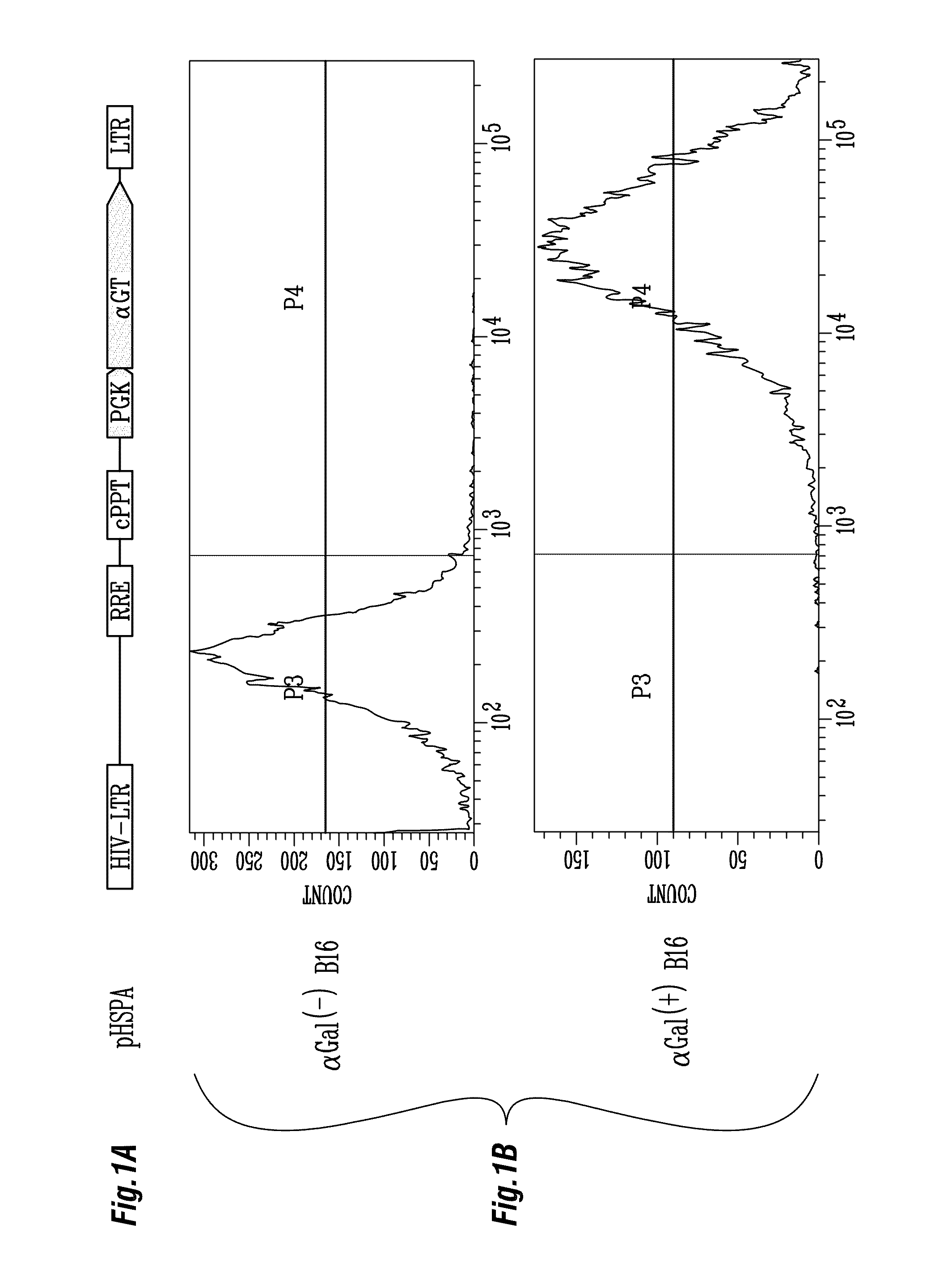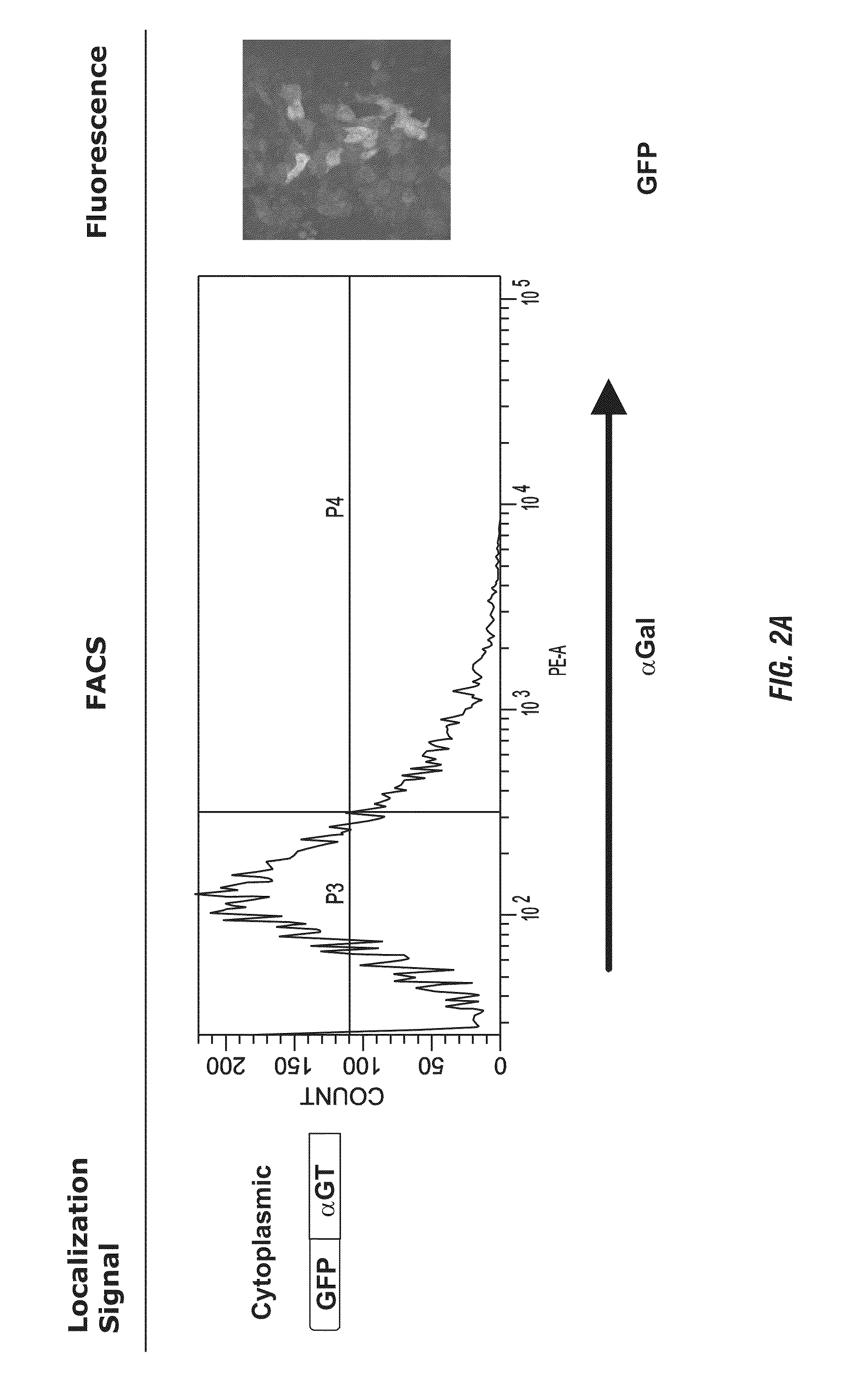Enhanced immunogenicity of tumor associated antigens by addition of alphaGal epitopes
an immunogenicity and tumor technology, applied in the field of tumor associated antigens enhanced immunogenicity by addition of alphagal epitopes, can solve the problems of weak antigen presentation, huge need for new immunotherapies, and cancer is one of the major causes of death worldwide, and achieve enhanced fcr-mediated capture of taa-anti-gal immunocomplexes. , the effect of increasing the immunogenicity
- Summary
- Abstract
- Description
- Claims
- Application Information
AI Technical Summary
Benefits of technology
Problems solved by technology
Method used
Image
Examples
example 1
Production of Retroviral Vector Expressing αGT, pLNCKG
[0146]A 1,077 base pair (bp) fragment of murine αGT gene was PCR amplified by a forward primer, 5′-ACAAAAGCTTGACATGGATGTCAAGGGAAAAGTAAT-3′, (SEQ ID NO: 1) which contains a Kozak sequence to enhance the translation of αGT, and a reverse primer, 5′-AATTATCGATTCAGACATTATTTCTAAC-3′ (SEQ ID NO: 2), and then cloned into the ClaI and HindIII sites of pLNCX to produce pLNCKG retroviral vector (FIG. 2). This vector was transfected into the packaging cell line 293.AMIZ to generate the vector producer cell line 293.AMIZ / LNCKG (Young and Link 2000). Transfected cells were selected in presence of G418 and ZEOCIN™ antibiotic for two weeks. Mixed population of selected cells was subcloned by limiting dilutions. Single cell-derived VPC were screened for their ability to effectively transduce human epithelial cancer cell lines established from different tissues. The clone which supernatant consistently yielded highest transduction efficiency and ...
example 2
Production of Lentiviral Vector Expressing αGT, pHSPA
[0147]A PCR fragment containing the human phosphoglycerate kinase (PGK) promoter was amplified from pHPEA3 (Mautino and Morgan 2002) using primers 5′-CAGGAATTCACGGGGTTGGGG-3′ (SEQ ID NO: 3) and 5′-TGACGTACGATTAGCTT GATCATCCCCCTG-3′ (SEQ ID NO: 4), digested with BspEI (completely filled in) and EcoRI and cloned in the EcoRI-EcoRV restriction sites of pLITMUS29 (New England Biolabs) to yield plasmid pLPGK. A PCR fragment of murine αGT gene was PCR amplified by a forward primer, 5′-ACAAAAGCTTGACATGGATGTCAAGGGA AAAGTAAT-3′ (SEQ ID NO: 5), which contains a Kozak sequence to enhance the translation of αGT, and a reverse primer, 5′-ATTGGTACCTCAGACATTATTTCTAAC-3′ (SEQ ID NO: 6) and cloned in the HindIII-KpnI sites of pLPGK. The PGK-αGT expression cassette was excised from pLPGK with EcoRI-KpnI and cloned in the same restriction sites of pHCPE (Mautino and Morgan 2002). Infectious vector particles were produced by transient cotransfection ...
example 3
Transduction of CHO Cells with LNCKG Retroviral Vector
[0148]CHO cells are extensively used to produce recombinant proteins and antibodies secreted into the culture medium (Werner et al. 1998). Despite being derived from a Chinese hamster which has a functional gene encoding αGT, CHO cells are αGal(−) (Sharma et al. 1996). To generate αGal(+) CHO cells, 2×106 cells are transduced with 2 mL of supernatant containing the LNCKG retrovirus with an infectious titer of 2×106 transducing units / mL. Cells are selected for resistance to Neomycin by a two-week selection in medium supplemented with G418 1 mg / mL. After this period of selection, cells are stained for expression of the αGal epitope with a chicken anti-αGal polyclonal antibody and sorted by fluorescence activated cell sorting.
PUM
| Property | Measurement | Unit |
|---|---|---|
| pH | aaaaa | aaaaa |
| pH | aaaaa | aaaaa |
| pH | aaaaa | aaaaa |
Abstract
Description
Claims
Application Information
 Login to View More
Login to View More - R&D
- Intellectual Property
- Life Sciences
- Materials
- Tech Scout
- Unparalleled Data Quality
- Higher Quality Content
- 60% Fewer Hallucinations
Browse by: Latest US Patents, China's latest patents, Technical Efficacy Thesaurus, Application Domain, Technology Topic, Popular Technical Reports.
© 2025 PatSnap. All rights reserved.Legal|Privacy policy|Modern Slavery Act Transparency Statement|Sitemap|About US| Contact US: help@patsnap.com



